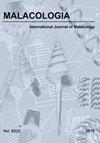在半自然地点无自然种群的罗马蜗牛(Helix pomatia Linnaeus, 1758)引种种群的生长速率和成熟度观察
IF 0.7
4区 生物学
Q4 ZOOLOGY
引用次数: 4
摘要
Helix pomatia Linnaeus, 1758年,罗马蜗牛,在欧洲被广泛用作食物。过度开发导致了《欧洲联盟生境指令》(欧洲共同体关于保护自然生境和野生动植物的指令(92/43/EEC))规定的保护措施。在波兰,该指令的实施涉及通过闭季收集、最小尺寸限制和允许收集区域的年度轮换等方式进行被动保护(Dyduch-Falniowska等人,2001年)。尺寸限制(最小外壳直径为30毫米)几十年来没有改变。双螺旋鱼的繁殖和成熟速度相对较慢(Ligaszewski et al., 2014)。已经努力在受控条件下改善这些(Jeppensen, 1976;Gomot, 1990;Chmielewski, 2005)。在波兰Balice国家动物生产研究所的实验中,从野外采集的成熟的pomatia在温室中繁殖成功,在秋季和冬季冬眠后都产生了大量的幼仔(Ligaszewski等人,2007)。虽然在蜗牛的整个生命周期(从卵到收获的成虫)中在这种条件下饲养蜗牛是昂贵的,但将幼螺释放到明显合适的栖息地可能会增加自然种群的数量,并在蜗牛面临剥削时为它们的未来提供保障。因此,这项研究开始确定在温室中饲养的幼螺的命运,并将其释放到半自然的、没有蜗牛的共生场所。研究了2011-2015年引种幼鱼的生长速率和扩散情况。《生物医学工程学报》,2016,59(2):341−346本文章由计算机程序翻译,如有差异,请以英文原文为准。
Observations on Growth Rates and Maturity in an Introduced Population of the Roman Snail (Helix pomatia Linnaeus, 1758) at a Semi-Natural Site with no Natural Population
Helix pomatia Linnaeus, 1758, the Roman snail, is widely exploited for food in Europe. Over-exploitation has led to protective measures laid down in the European Union Habitats Directive (European Community Directive on the Conservation of Natural Habitats and of Wild Fauna and Flora (92/43/EEC). In Poland, the implementation of this directive has involved passive protection by means of closed seasons for collecting, minimum size limits and annual rotation of areas in which collecting is permitted (Dyduch-Falniowska et al., 2001). The size limit (minimum shell diameter of 30 mm) has not changed for several decades. Helix pomatia has relatively slow reproductive and maturation rates (Ligaszewski et al., 2014). Efforts have been made to improve these under controlled conditions (Jeppensen, 1976; Gomot, 1990; Chmielewski, 2005). In experiments at the National Research Institute of Animal Production in Balice, Poland, mature H. pomatia taken from the wild and kept in greenhouses reproduced successfully, producing large numbers of hatchlings both in autumn and after the winter hibernation (Ligaszewski et al., 2007). While rearing snails in such conditions over the whole of their life cycle (eggs to harvested adults) is expensive, the release of juveniles into apparently suitable habitats might increase the number of natural populations and serve to secure the snail’s future in the face of exploitation. This study thus set out to determine the fate of juveniles reared in greenhouses and released into a semi-natural, synanthropic site in which the snail was absent. A target area was modified to provide good starting conditions, and the growth rate and dispersal of the introduced juveniles studied over the period 2011–2015. In particular, the study aimed to MALACOLOGIA, 2016, 59(2): 341−346
求助全文
通过发布文献求助,成功后即可免费获取论文全文。
去求助
来源期刊

Malacologia
生物-动物学
CiteScore
2.00
自引率
0.00%
发文量
15
审稿时长
3 months
期刊介绍:
Malacologia publishes papers on all groups of the Mollusca. Malacologia specializes in publishing long papers and monographic treatments. Complete data are especially appreciated. Papers must be of interest to an international readership. Papers in systematics, ecology, population ecology, genetics, molecular genetics, evolution and phylogenetic treatments are especially welcomed. Also welcomed are letters to the editor involving papers published or issues of import to science of the day.
 求助内容:
求助内容: 应助结果提醒方式:
应助结果提醒方式:


